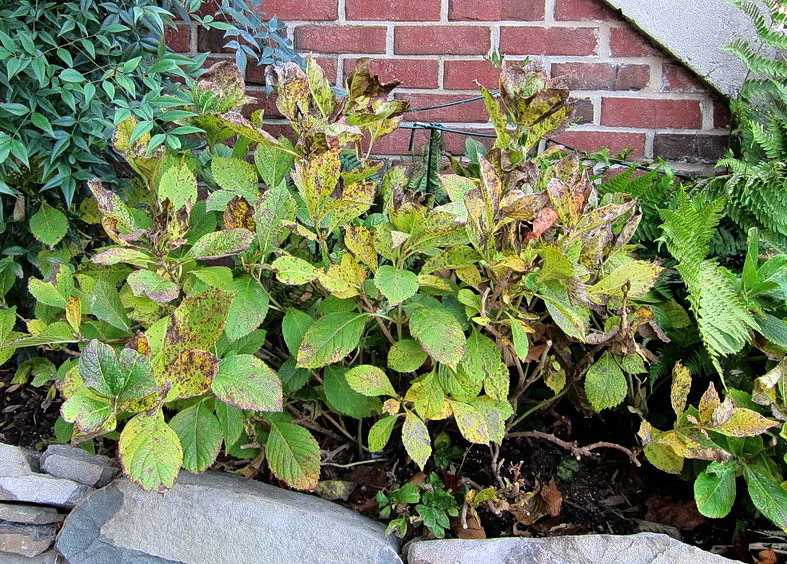8 Simple Techniques For Hydrangea Leaves Turning Yellow
An Unbiased View of Hydrangea Leaves Turning Yellow
Table of ContentsThe Facts About Hydrangea Leaves Turning Yellow UncoveredThe Basic Principles Of Hydrangea Leaves Turning Yellow The Ultimate Guide To Hydrangea Leaves Turning YellowHydrangea Leaves Turning Yellow for DummiesThe Main Principles Of Hydrangea Leaves Turning Yellow Not known Facts About Hydrangea Leaves Turning Yellow
Big leaves often look droopy throughout the mid-day warmth. When they stop working to perk up in the evening or still look wilted in the early morning, your plant might be overwatered.Remove the plant from the soil and trim out any kind of roots that aren't white and swollen (plump) (Hydrangea Leaves Turning Yellow). Replant in a new location or function some sand into the soil for far better water drainage. Underwatering additionally causes leaves to transform yellow with brownish, crunchy edges. Do not attempt to fix the issue by watering exceedingly.

The Ultimate Guide To Hydrangea Leaves Turning Yellow
likewise initially appears on the older fallen leaves, but the leaf capillaries remain eco-friendly. A magnesium shortage appears first on old fallen leaves and ought to not be perplexed with an iron shortage [Photo: izzzy71/ Shutterstock. com] While there is typically adequate iron in all-natural soil, hydrangeas commonly struggle to absorb enough of it.
The most effective method to protect against iron deficiency-chlorosis in hydrangeas is to grow them in suitable ericaceous or acidic soil. When planting in a bed, mix in some peat or reduced-peat ericaceous garden compost and examine the p, H worth yearly. This is necessary because the compost blend around the plants will certainly affect the p, H worth of the soil in the future and the p, H value might climb once more.

Hydrangea Leaves Turning Yellow - Questions
September is the ideal time of year to do something concerning those hydrangeas. Their leaves are turning yellow, the blossoms have discolored, and their gangly look is making you crazy.
Now to encounter the staying bush, not a pretty sight as wintertime strategies. Mophead, Lacecap and Oakleaf hydrangeas flower on old timber. What that implies is they will certainly bloom following year check out this site on wood that was developed this year. Do not trim Mophead, Lacecaps and Oakleaf hydrangeas to the ground, as you will certainly eliminate the stems that prepare to bloom next spring.
That means you won't be eliminating also many of next year's blossom buds. If the bush is obtaining larger than you like, you can take out a third of the real-time wood while you're in there.
Hydrangea Leaves Turning Yellow - An Overview
We're best in the middle of our late-blooming hydrangea period here, so I thought I 'd share a pointer for this specific sort of hydrangea that I found really fascinating. A great deal of people have a comparable concern with their panicle hydrangeas where they begin to see the leaves turning yellow and leaving at different parts of the season and it can be quite remarkable and quite worrying since it can occur truly promptly on a hedge that appears like it's otherwise truly healthy and balanced.
I've shared it on Instagram prior to, however I recognized I've never told you about this in a real, full blog site article, so today I'm looking after that. When I state that this puts on panicle hydrangeas, that indicates the type of hydrangeas that generally bloom later on in summer season, usually around August.
Where we reside in area 6, they're rather very easy to have success with and they're actually preferred in our location, which is great because that suggests that there are hydrangeas almost almost everywhere right now of year. When you see your hydrangea leaves beginning to transform yellow, you could believe that your plant is dying or being maltreated in some means, however in truth, the opposite holds true.
The Main Principles Of Hydrangea Leaves Turning Yellow

Courtenay is the author of the publication The Cleansing Ninja and has been included in various magazines including Country Sampler Farmhouse Style, browse around these guys Better Residences and Gardens, Parents Magazine, Real Simple, and Our Residences.
Water logged soil denies the roots of oxygen, causing root rot and yellow fallen leaves. On the other hand, underwatering or dehydration find out triggers the plant to wilt and its vegetation to yellow. Preserving a regular watering routine and making certain proper water drainage through drainage openings or layers can aid avoid these issues.
Rumored Buzz on Hydrangea Leaves Turning Yellow
Consistently examine the soil acidity, and adjust as required to preserve the optimum p, H degree for hydrangeas. With proper care and upkeep, hydrangeas can grow and maintain their dazzling, vivid fallen leaves. Hydrangea leaves turning yellow is a common issue that can be connected to different variables. Among the key factors is improper watering, as hydrangeas need continually moist dirt to prosper.
The kind of yellowing seen (e. g. the position of the impacted leaves on the plant, and/or the pattern and setting of the yellowing on the leaf itself) will usually differ according to the reason. The chlorosis is often accompanied by other signs giving more ideas regarding the cause, e.Examples consist of sap-sucking insects such as aphids, red crawler termites and whiteflies, and root feeders such as creeping plant weevil and cabbage root fly. When again it is usually feasible to find the offender on the fallen leaves or among the roots.